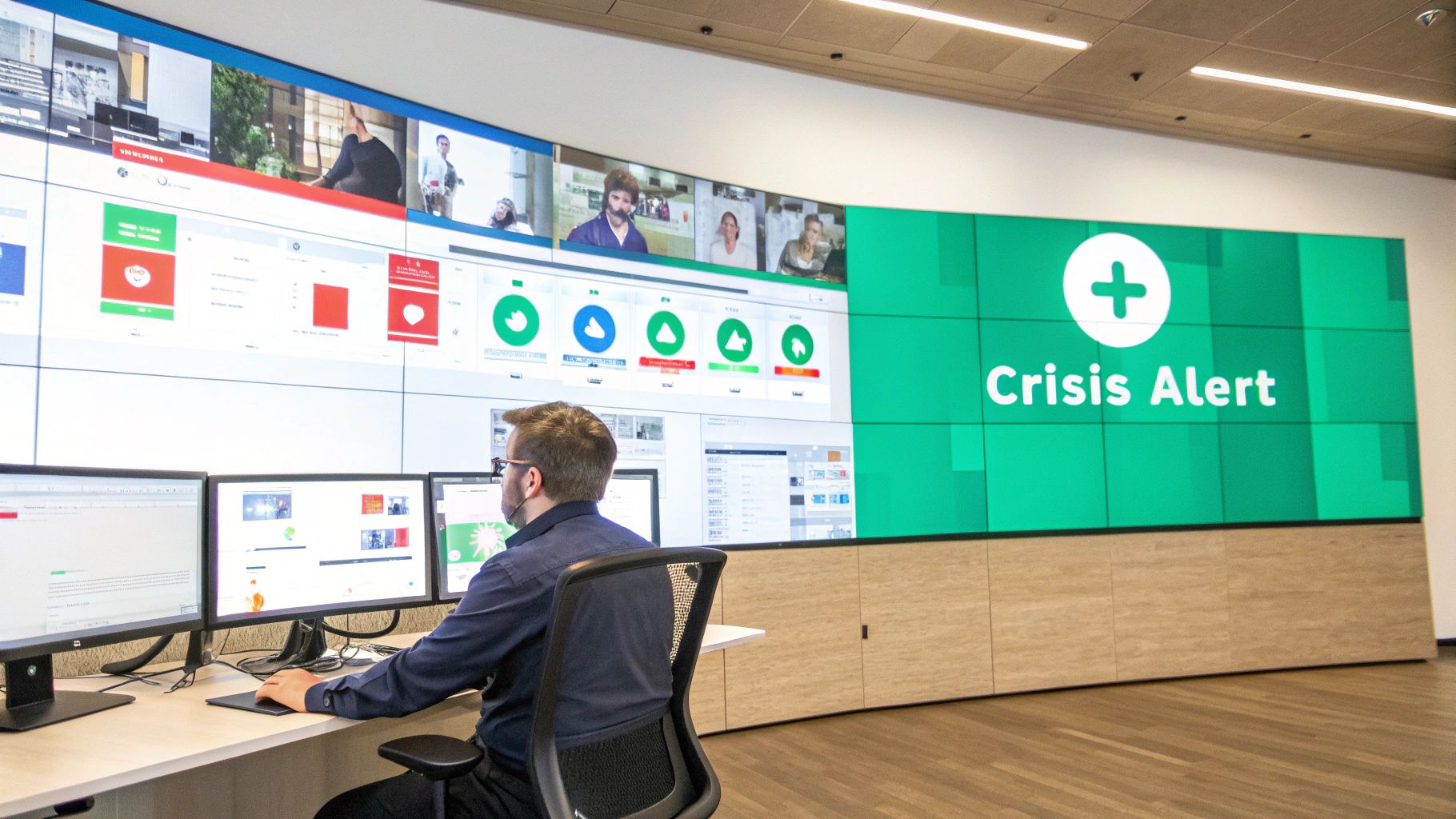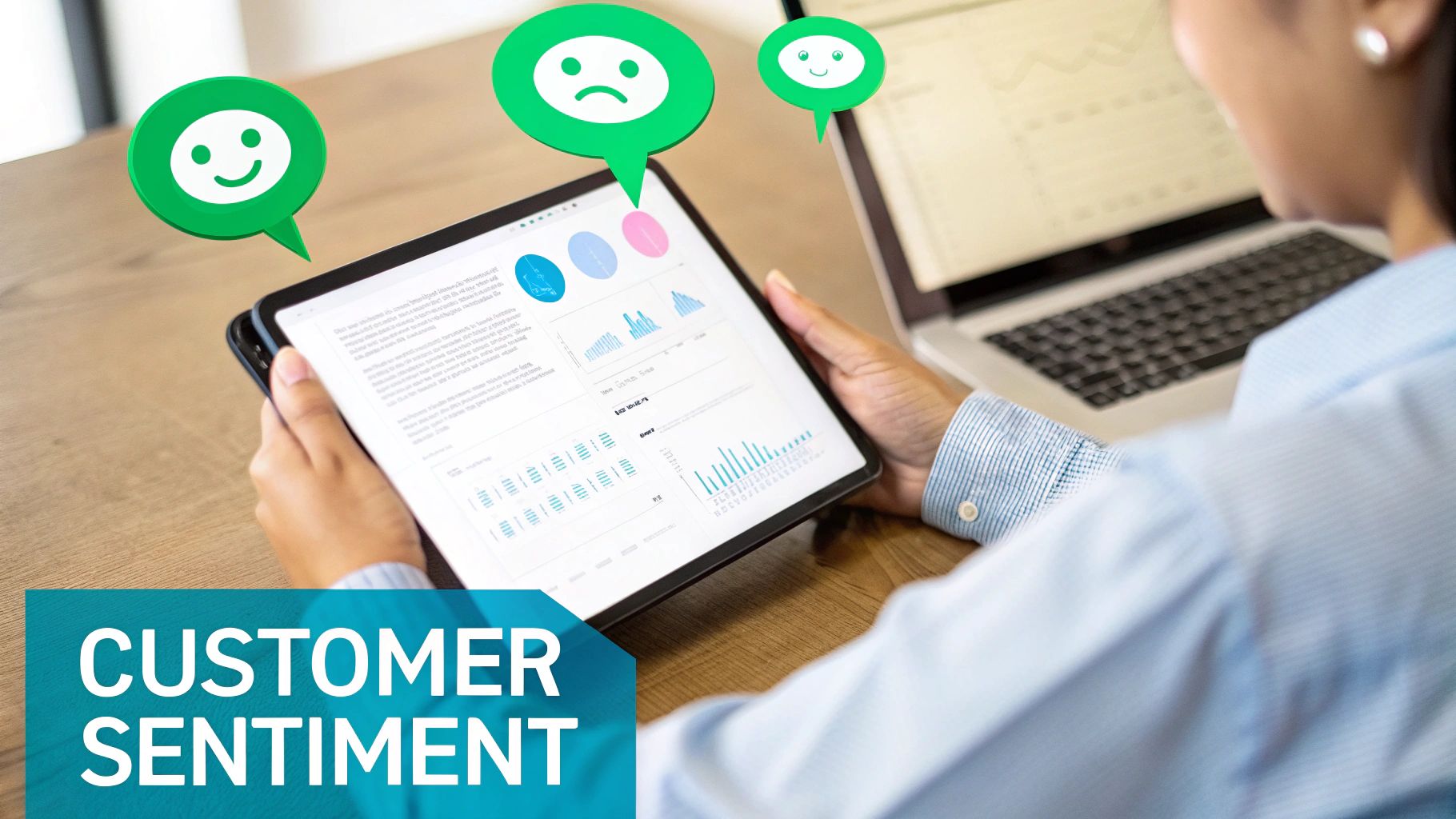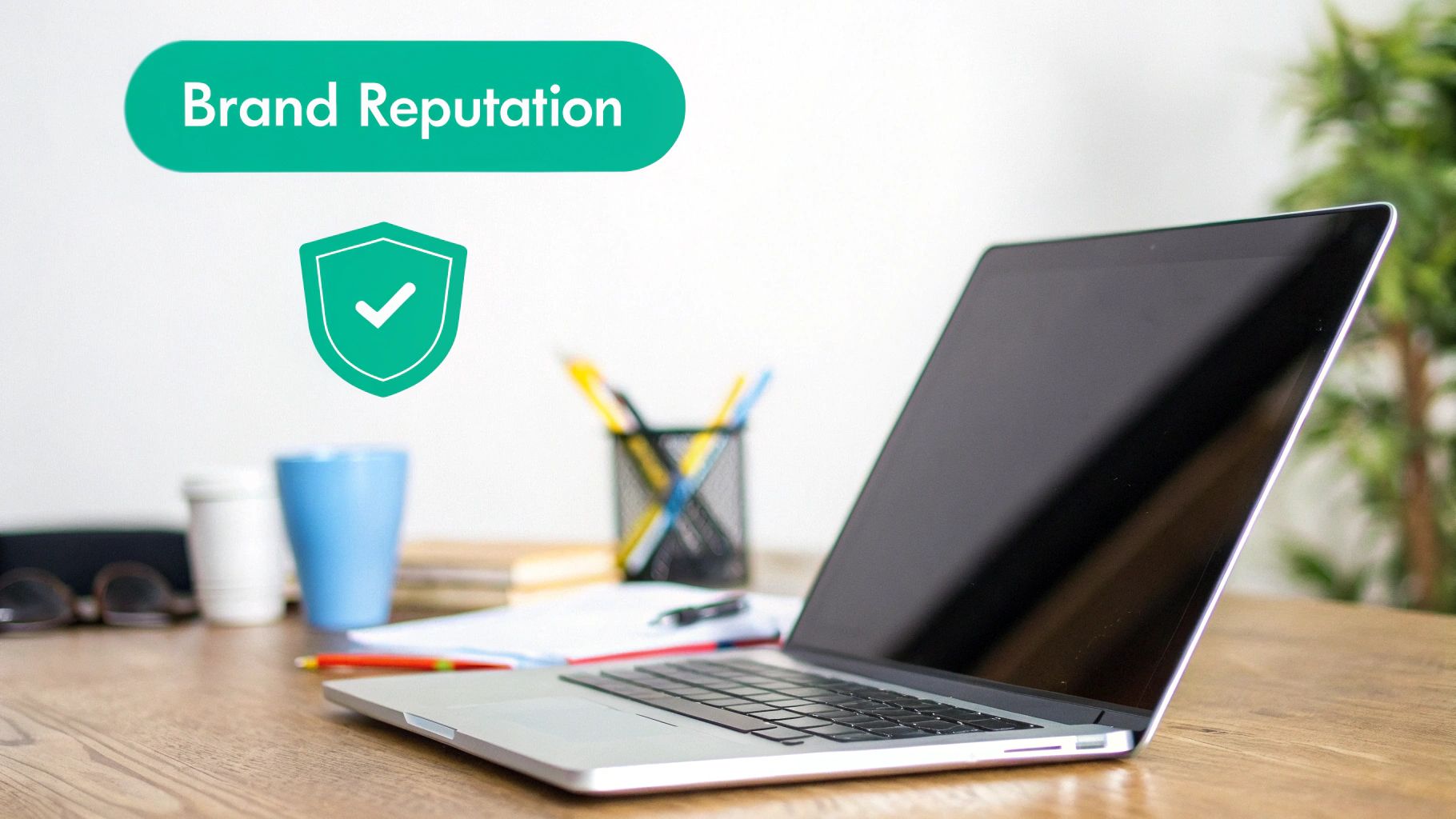9 Key Advantages of Social Media Monitoring in 2025
In a world where millions of conversations happen online every second, are you tuned into what customers, competitors, and critics are saying about your brand? The digital landscape is a goldmine of actionable data, but without the right tools, it's just noise. Social media monitoring is no longer a 'nice-to-have' for marketing teams; it's a critical business intelligence function that impacts everything from product development to crisis management.
The core advantages of social media monitoring lie in its ability to transform unstructured social chatter into strategic insights. This article dives into nine pivotal benefits that demonstrate how listening actively can protect your reputation, uncover sales opportunities, and give you a decisive competitive edge. To effectively listen online and uncover these critical insights, exploring a social media monitoring tools comparison can guide your choice in finding the right platform for your specific needs.
We'll explore practical examples and actionable steps to help you harness these benefits, highlighting how platforms can automate the process of finding high-intent conversations on Reddit, X, and LinkedIn. Ultimately, this guide will show you how to turn passive listening into a powerful engine for proactive growth.
1. Real-Time Crisis Management and Response
One of the most critical advantages of social media monitoring is the ability to engage in real-time crisis management. Negative comments or PR issues can escalate from a single post into a full-blown reputation crisis within hours. Monitoring tools act as an early warning system, allowing your team to detect and address potential threats before they gain momentum and cause significant damage to your brand’s credibility.

This proactive approach transforms your brand from a passive target into an active participant in shaping its own narrative. For example, when KFC faced a massive chicken shortage in the UK in 2018, they used social listening to understand customer frustration. Their witty, apologetic, and transparent responses on Twitter turned a potential disaster into a widely praised PR masterclass. This highlights how immediate engagement can defuse tension and even strengthen customer loyalty.
How to Implement Proactive Crisis Monitoring
To effectively manage potential crises, you need a structured plan that leverages monitoring tools like Intently. Start by identifying potential risks and establishing a clear response protocol.
- Set Up Keyword Alerts: Configure real-time alerts for your brand name, common misspellings, product names, and executive leadership. Also, monitor competitor names and industry-specific keywords that could signal a wider issue.
- Establish a Response Protocol: Create a clear, pre-approved plan that outlines who responds, what they should say, and when to escalate an issue to senior management or legal teams. This eliminates delays when time is critical.
- Monitor Sentiment Shifts: Pay close attention to sudden negative shifts in sentiment. A rapid increase in negative mentions is a clear indicator that an issue is starting to trend and requires immediate attention.
By preparing in advance, you can ensure a swift and organized reaction. You can learn more by exploring our detailed guide on social media crisis management.
2. Customer Insight and Sentiment Analysis
Another one of the core advantages of social media monitoring is its ability to unlock authentic customer insights and analyze public sentiment. Social platforms are a goldmine of unfiltered opinions, preferences, and pain points that offer market intelligence far more genuine than traditional surveys. Monitoring these conversations helps you understand your audience's emotional responses to your brand, products, and campaigns on a much deeper level.

This direct feedback loop allows companies to be more agile and customer-centric. For instance, Netflix meticulously analyzes viewer reactions on social media after a new release to inform its content strategy and marketing efforts. Similarly, Airbnb frequently adjusts its host and guest policies based on widespread feedback and sentiment trends identified through social listening. This approach ensures that business decisions are grounded in real-world customer experiences, not just internal assumptions.
How to Implement Customer Sentiment Analysis
To effectively tap into customer insights, you need a systematic approach that goes beyond simply counting mentions. Using a tool like Intently, you can categorize and interpret the emotional undertones of conversations at scale.
- Analyze Emotional Nuances: Use natural language processing (NLP) to go beyond positive, negative, or neutral classifications. Identify specific emotions like joy, anger, or frustration to understand the "why" behind customer sentiment.
- Segment Your Data: Break down sentiment data by demographics, location, or customer cohorts. This helps you understand if a specific issue is affecting a particular segment of your audience more than others.
- Track Sentiment Over Time: Monitor sentiment trends before, during, and after a product launch or marketing campaign. This allows you to accurately measure the impact of your initiatives on public perception.
By systematically analyzing sentiment, you can transform raw social data into actionable business intelligence. You can discover more about this process by reading about the best social media sentiment analysis tools.
3. Competitive Intelligence and Benchmarking
One of the most powerful advantages of social media monitoring is gaining deep competitive intelligence. By systematically tracking your competitors' online activities, you can deconstruct their strategies, understand their audience's reactions, and identify gaps in the market. This goes beyond simply seeing what they post; it’s about analyzing their campaign performance, messaging effectiveness, and overall market positioning to inform and refine your own approach.
This strategic oversight allows you to move from reactive imitation to proactive innovation. For instance, a fast-fashion brand can monitor rivals to see which new trends are gaining the most traction with their target demographic, allowing for faster and more strategic product launches. Similarly, a B2B SaaS company can track a competitor’s feature launch announcements and monitor the customer feedback, identifying pain points or unmet needs that its own product can solve.
How to Implement Competitive Benchmarking
A structured approach to competitor analysis ensures you gather actionable insights, not just raw data. Using a tool like Intently, you can automate this process to stay consistently ahead of the curve.
- Create a Competitor Watch List: Identify your top direct and indirect competitors and set up dedicated monitoring streams for their social media accounts, brand mentions, and key product names.
- Analyze High-Engagement Content: Systematically review which of your competitors' posts, campaigns, and content formats generate the most likes, shares, and comments. This reveals what resonates with your shared target audience.
- Benchmark Key Metrics: Track your share of voice, engagement rates, and sentiment scores against your competitors over time. This data provides a clear, objective measure of your performance within the competitive landscape.
By embedding this process into your marketing workflow, you can continuously adapt and optimize your strategy. You can discover more by reading our guide to competitive intelligence gathering.
4. Product Development and Innovation Insights
A significant advantage of social media monitoring is its power to fuel product development and innovation. By tuning into unsolicited, organic conversations, companies can capture a wealth of user feedback, identify unmet needs, and discover innovative ideas directly from the people who use their products. This stream of real-world insights allows you to move beyond internal assumptions and build features that genuinely resonate with market demand.
This process transforms your customer base into a de facto research and development team. For instance, the LEGO Ideas platform was born from observing how fans shared custom creations online. LEGO harnessed this user-generated innovation, creating a system where fan designs could become official products. Similarly, tech companies like Slack and Twitter constantly monitor user discussions to prioritize bug fixes and implement highly requested features, accelerating their development cycles and ensuring their products evolve with user expectations.
How to Implement Feedback-Driven Product Development
To turn social conversations into tangible product improvements, you need a system for collecting, analyzing, and acting on customer feedback. This ensures that valuable insights are not lost in the noise.
- Track Feature Requests and Pain Points: Set up alerts to monitor keywords related to feature requests (e.g., "I wish [your product] could," "add a feature for") and common pain points. This helps you quantify demand for specific improvements.
- Establish a Feedback Loop: Create a formal process to share key findings from social media with your product and engineering teams. Regular reports or dedicated meetings can bridge the gap between customer conversations and development priorities.
- Monitor Request Sentiment: Analyze the sentiment tied to feature requests. Enthusiastic and positive suggestions may indicate an opportunity for a delightful new feature, while frustrated requests highlight urgent problems that need to be solved to prevent customer churn.
5. Brand Reputation and Image Management
Another of the core advantages of social media monitoring is its direct impact on building and protecting your brand reputation. In today's digital landscape, public perception is shaped by online conversations. By continuously tracking brand mentions, sentiment, and relevant keywords, you can understand how your audience perceives you and proactively manage your brand’s narrative, preventing minor issues from turning into major reputational threats.

This ongoing management allows you to address negativity systematically and amplify positivity. For instance, following major crises, companies like Volkswagen and Uber heavily relied on social monitoring to gauge public sentiment, identify key concerns, and tailor their communication strategies to rebuild trust. This shows that reputation management is not just about crisis control; it is about the long-term, strategic shaping of your brand's image by listening and responding to your community.
How to Systematically Manage Brand Reputation
To effectively manage your brand's image, you need a systematic approach that goes beyond simply reacting. Tools like Intently can help you establish a baseline and track changes over time.
- Establish Baseline Metrics: Before a crisis, measure your current sentiment score, share of voice, and common discussion topics. This baseline makes it easier to spot unusual deviations and measure the impact of your campaigns.
- Monitor Beyond Direct Mentions: Track industry hashtags, competitor conversations, and related topics to understand the broader context in which your brand operates. This provides a more complete picture of your reputation.
- Create Rapid Response Templates: Prepare pre-approved templates for common negative scenarios, such as product complaints or service issues. This ensures a consistent, professional, and timely response.
- Celebrate Positive Advocacy: Actively monitor for positive mentions and user-generated content. Share these stories to amplify brand advocacy and build social proof, reinforcing a positive brand image.
6. Influencer Identification and Partnership Opportunities
Another key advantage of social media monitoring is its ability to pinpoint influential voices and organic brand advocates within your niche. By tracking conversations related to your industry and products, you can identify individuals whose content genuinely resonates with your target audience. This allows you to move beyond guesswork and build strategic partnerships that drive authentic engagement and brand trust.
This data-driven approach helps you find creators who are a natural fit for your brand, not just those with the largest follower counts. For example, watch brand Daniel Wellington built its empire almost entirely on a micro-influencer strategy. They identified thousands of smaller creators whose aesthetic matched their own, providing them with free products in exchange for posts. This created a groundswell of authentic-looking content that felt more like a trend than an advertisement, proving the power of targeted, community-driven influence.
How to Find and Vet Potential Influencers
To leverage monitoring tools for influencer marketing, focus on relevance and authenticity. A strategic approach will yield far better results than simply chasing follower metrics.
- Identify Organic Advocates: Set up alerts to find users who are already mentioning your brand positively without being paid. These individuals are your most powerful potential partners because their endorsement is genuine.
- Analyze Audience Alignment: Look beyond an influencer’s follower count and analyze their audience demographics and engagement rates. A creator with 10,000 highly engaged, relevant followers is more valuable than one with 100,000 disengaged or mismatched followers.
- Track Relevant Keywords and Hashtags: Monitor conversations around specific topics, pain points, or interests relevant to your brand. This will reveal the key opinion leaders who are shaping discussions and have earned the trust of your potential customers.
7. Marketing Campaign Performance and Optimization
A key advantage of social media monitoring is its power to track and optimize marketing campaign performance in real time. Instead of waiting for post-campaign reports, you can gauge audience engagement, message resonance, and ROI as the campaign unfolds. This continuous feedback loop allows marketers to make data-driven adjustments on the fly, ensuring maximum impact and efficiency for their advertising spend.
This agile approach means you can double down on what’s working and pivot away from underperforming assets. For instance, Nike frequently adjusts its campaign creative based on initial social media reactions, ensuring its messaging always hits the mark. Similarly, Airbnb tests different campaign messages across various markets, using social listening to identify which narratives resonate most deeply with local audiences. Beyond direct advertising, social media monitoring provides critical data to optimize various marketing campaigns, including strategies for building successful effective referral programs.
How to Optimize Campaigns with Social Data
To transform campaign data into actionable improvements, you need a systematic monitoring process. Start by defining what success looks like and then track progress against those metrics.
- Establish Clear KPIs: Before launching, define your key performance indicators (KPIs), such as engagement rate, share of voice, reach, and conversion-related mentions.
- Monitor Engagement Daily: Track likes, comments, shares, and sentiment daily to identify high-performing content. This helps you understand which themes, formats, and platforms are driving the most value.
- Compare Across Platforms: Analyze how the same content performs on different channels like Instagram, X (formerly Twitter), and LinkedIn. This reveals platform-specific audience preferences you can leverage in future campaigns.
- Set Alerts for Underperformance: Create automated alerts to notify you if certain posts or ads are receiving negative sentiment or significantly lower-than-average engagement, allowing for swift intervention.
8. Customer Service Excellence and Support Efficiency
Another of the key advantages of social media monitoring is its ability to transform your customer service operations. Instead of waiting for customers to file support tickets or call a helpline, monitoring tools allow you to proactively identify and engage with inquiries, complaints, and service issues directly on social channels. This real-time, public-facing support demonstrates a commitment to customer care and significantly improves satisfaction.

This approach not only resolves individual problems but also builds brand loyalty by showing that you listen and respond promptly. For instance, airlines like JetBlue are known for quickly responding to travelers' concerns about flight issues on Twitter, turning a negative experience into a positive customer interaction. Similarly, Zappos has built a legendary reputation for its exceptional and personal customer service on social media, resolving issues efficiently and strengthening its customer-centric image.
How to Implement Social Media Customer Support
To elevate your customer service, integrate social media monitoring into your support workflow with a clear and efficient process. This ensures no customer query goes unanswered.
- Set Response Time Targets: Establish a goal for your team to respond to all mentions within a specific timeframe, such as one hour. This sets a standard for promptness and manages customer expectations.
- Create Response Templates: Develop pre-approved templates for common questions or issues. This speeds up response times while ensuring brand voice consistency, but always encourage personalization.
- Establish an Escalation Path: Define a clear protocol for escalating complex or sensitive issues to specialized support teams. This ensures customers are directed to the right expert quickly, preventing further frustration.
9. Trend Identification and Content Strategy Development
Another of the key advantages of social media monitoring is its ability to reveal emerging trends, viral moments, and cultural conversations in real-time. By tapping into these discussions, your brand can develop a content strategy that is timely, relevant, and highly engaging. Monitoring tools help you move beyond a static content calendar and capitalize on trending topics to maintain cultural relevance and boost visibility.
This agile approach allows your brand to become part of the cultural zeitgeist rather than just an observer. For instance, Wendy's has famously built its brand voice by wittily engaging with memes and current events, while Netflix consistently ties its content promotion to trending pop culture moments. These brands don't just create content; they participate in conversations, which significantly increases their organic reach and audience connection.
How to Leverage Trends for Content Strategy
To effectively integrate trend identification into your content plan, you need a process that combines monitoring with quick, creative execution. This ensures your content is both timely and on-brand.
- Monitor Industry-Specific Trends: Set up alerts for hashtags, keywords, and topics relevant to your niche. Use tools that can notify you when certain keywords begin to spike in conversation, signaling an emerging trend.
- Create a Flexible Content Calendar: While a planned calendar is essential, leave room for spontaneous, trend-driven content. Develop a rapid approval process to ensure you can act on a viral moment before it fades.
- Balance Trending and Evergreen Content: A successful strategy mixes timely, viral content with evergreen messaging that reinforces your core brand values. This balance ensures you stay relevant without losing your brand identity.
9-Point Comparison of Social Media Monitoring Advantages
| Item | 🔄 Implementation Complexity | ⚡ Resource Requirements | 📊 Expected Outcomes | 💡 Ideal Use Cases | ⭐ Key Advantages |
|---|---|---|---|---|---|
| Real-Time Crisis Management and Response | High — 24/7 monitoring, rapid escalation workflows | Dedicated team + paid monitoring & alerting tools | Immediate detection & faster mitigation; reduced reputational loss | Large brands, PR teams, high-risk industries | Prevents misinformation; rapid damage control |
| Customer Insight and Sentiment Analysis | Medium — requires NLP models and segmentation | Analytics platforms, data engineers / analysts | Deeper customer understanding; trend & emotion signals | Product strategy, CX improvements, market research | Captures unsolicited feedback; cost-effective insight |
| Competitive Intelligence and Benchmarking | Medium — ongoing tracking and comparative analysis | Competitor monitoring tools, analyst time | Benchmarks, strategy signals, market gap identification | Strategic planning, market positioning, campaign prep | Reveals competitor tactics; informs differentiation |
| Product Development and Innovation Insights | Medium–High — feedback aggregation + cross-team workflows | Integration with product tools, community channels | Prioritized feature requests; lower product risk; faster launches | Product teams, beta programs, roadmap planning | Customer-driven features; builds community buy-in |
| Brand Reputation and Image Management | Medium–High — continuous monitoring + strategic response | Reputation platforms, PR/comms experts, reporting tools | Early warnings; measurable reputation health over time | Corporate comms, regulated sectors, exec reporting | Quantifiable reputation metrics; targeted repair |
| Influencer Identification and Partnership Opportunities | Medium — vetting, negotiation, relationship management | Influencer tools, campaign budget, vetting processes | Targeted reach amplification; improved authenticity | Brand awareness campaigns, niche audience targeting | Authentic endorsements; scalable influencer tiers |
| Marketing Campaign Performance and Optimization | Medium — requires attribution & A/B testing capability | Advanced analytics, campaign managers, tracking systems | Higher ROI via mid-campaign optimization; faster learning | Active campaigns, performance marketing teams | Real-time optimization; better budget allocation |
| Customer Service Excellence and Support Efficiency | Medium — routing, templates, escalation rules | Support staff, CRM/chatbot integration, SLAs | Faster resolution; lower ticket volume; improved CSAT | Customer-facing brands, e-commerce, service providers | Public responsiveness; reduces support costs |
| Trend Identification and Content Strategy Development | Low–Medium — real-time listening and creative agility | Trend tools, agile content team, rapid approval | Timely, relevant content; increased organic visibility | Social-first brands, content/social teams | Capitalizes on viral moments; boosts engagement |
From Listening to Leading: Your Next Strategic Move
The digital landscape is a vast, ever-changing ocean of conversations, opinions, and opportunities. Navigating it without the right tools is like sailing blind. As we've explored, the advantages of social media monitoring are not just a series of isolated benefits; they are interconnected components of a powerful, unified strategy that transforms your brand from a passive observer into an active, intelligent market leader.
You have seen how a proactive monitoring strategy can be your first line of defense in crisis management, turning potential disasters into demonstrations of customer care. We have detailed how analyzing sentiment and customer feedback moves you beyond guesswork, providing a direct line to what your audience truly wants, which is essential for product innovation and refining your marketing messages. By systematically tracking competitors, you gain a critical edge, allowing you to benchmark performance and identify exploitable gaps in the market.
Synthesizing Insights into Action
The true power of this practice emerges when you connect these disparate streams of information. The insights you gain are not just data points; they are strategic assets.
- From Insight to Influence: Identifying key trends and influential voices enables you to craft a content strategy that resonates deeply and positions your brand at the forefront of your industry.
- From Service to Loyalty: Proactively addressing customer service issues in public forums not only solves a single problem but also builds a reputation for excellence that attracts new customers.
- From Chatter to Revenue: Perhaps most critically, social media monitoring uncovers direct buying signals and high-intent conversations, turning passive listening into an active lead generation engine.
Ultimately, mastering social media monitoring is about closing the gap between your brand and the market. It’s about understanding the "why" behind customer behavior, anticipating market shifts before they happen, and engaging with your audience with authenticity and precision. The conversations that will define your brand's future are happening right now, whether you are part of them or not. By embracing a robust monitoring framework, you ensure you are always in the right place, at the right time, with the right message. This isn't just about managing your reputation; it's about actively shaping your destiny in a crowded digital world.
Ready to turn social conversations into qualified leads without the manual effort? Intently uses AI to scan platforms like Reddit and X for high-intent signals, delivering actionable opportunities directly to your team. Stop searching and start selling by visiting Intently to see how you can automate your lead generation.
